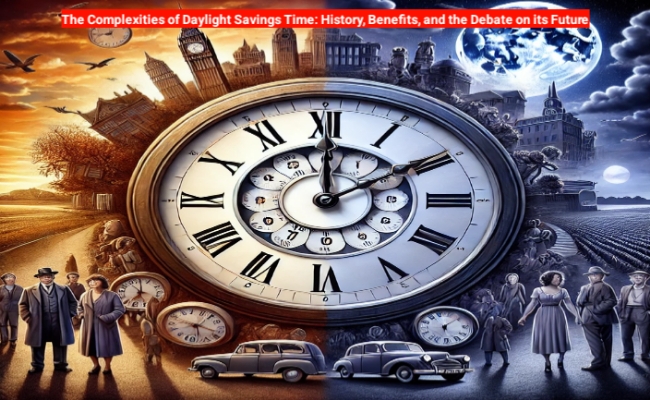The Complexities of Daylight Savings Time: History, Benefits, and the Debate on its Future, its potential drawbacks, and the growing calls to either end or reform the practice.
The Complexities of Daylight Savings Time
Daylight Savings Time (DST) is a practice that millions around the world follow, setting their clocks forward by one hour in spring and then moving them back again in the fall. While the concept seems simple enough, DST has sparked ongoing debates, and recent years have seen more countries questioning whether it should continue. This article delves into the history of DST, its intended benefits, its potential drawbacks, and the growing calls to either end or reform the practice.
The Origins of Daylight Savings Time
The idea behind DST is to make better use of daylight during the longer days of spring and summer. The concept has been attributed to Benjamin Franklin, who, in 1784, suggested that people could save on candles by waking up earlier during summer mornings. However, the modern system of DST was first proposed by New Zealand entomologist George Hudson in 1895. Hudson, who wanted more daylight after work to study insects, suggested a two-hour shift forward in October and back in March.
The first widespread adoption of DST occurred during World War I, when Germany implemented it in 1916 as a way to conserve fuel by reducing the need for artificial lighting. Soon after, the United Kingdom, the United States, and other countries followed. The idea was to maximize sunlight hours in the evening, thus reducing the use of coal and other resources needed for artificial lighting.
The Purpose and Potential Benefits of DST
The primary aim of DST has historically been energy conservation. The logic is straightforward: with more daylight during the evening hours, people would theoretically use less electricity for lighting and heating. Over the years, studies have shown mixed results regarding energy savings. Some have shown modest reductions in energy use, while others indicate little to no effect, especially as technology and lighting efficiency have evolved.
Beyond energy conservation, DST has other purported benefits:
- Economic Boost: Longer daylight hours in the evening can encourage people to go out more, spending time and money in recreational activities, dining, shopping, and entertainment, which can positively impact local economies.
- Reduced Traffic Accidents: Some research has indicated that DST could lead to fewer car accidents by allowing for more daylight during the hours people commute. The idea is that more light reduces the likelihood of accidents due to improved visibility.
- Increased Physical Activity: Extended daylight hours encourage people to engage in outdoor activities after work or school, promoting physical health and well-being.
- Crime Reduction: Studies have suggested that increased daylight can lead to a decrease in certain types of crime, as criminals are less likely to commit offenses in well-lit conditions.
The Drawbacks and Health Impacts of DST
While DST has several potential benefits, the practice also has notable drawbacks. The biannual clock changes can disrupt circadian rhythms, affecting sleep patterns and overall health. Research has found that the shift in time can result in increased fatigue, leading to higher rates of workplace accidents, heart attacks, and even strokes immediately after the switch.
- Sleep Disruptions: Adjusting to a new time affects the body’s internal clock, which can lead to insomnia, irritability, and reduced productivity, especially in the days following the clock change. For people with existing sleep disorders, this can be particularly challenging.
- Mental Health Effects: Disruption to natural sleep patterns has also been linked to an increase in mental health issues, including heightened anxiety and depression. Studies suggest that even small disturbances in sleep can impact mental health, particularly for those already prone to mood disorders.
- Negligible Energy Savings: With the evolution of energy-efficient technologies, the savings that DST was intended to bring have diminished significantly. For example, the increased use of air conditioning in warmer climates during DST hours can actually lead to higher energy consumption.
- Economic Costs: In some industries, the changes in time can lead to reduced productivity, especially for businesses that operate across different time zones. Missed meetings, scheduling conflicts, and other complications can result in financial losses.
The Global Debate on Daylight Savings Time
Over the years, many countries have reconsidered or entirely abandoned DST. While DST remains widely practiced across North America, Europe, and parts of the Middle East, many countries in Africa, Asia, and South America have chosen not to implement it.
In 2018, the European Union (EU) proposed to end the practice of changing the clocks twice a year, citing studies that questioned its effectiveness and highlighted its impact on health. Each EU member state was given the choice to decide whether they would remain on permanent standard time or permanent daylight saving time. However, a consensus has yet to be reached, and the proposal has stalled.
In the United States, the debate over DST continues. Currently, DST begins on the second Sunday in March and ends on the first Sunday in November. Some states have expressed interest in moving to permanent DST, including Florida and California, but such a change would require federal approval. In 2022, the U.S. Senate passed the Sunshine Protection Act, which aimed to make DST permanent nationwide, but the bill has yet to pass in the House of Representatives.
Countries That Have Abolished DST
Several countries have discontinued DST after experimenting with it. For example, Russia adopted permanent DST in 2011 but switched back to standard time in 2014 due to public discontent and health complaints. Similarly, countries such as Argentina, India, and Japan do not observe DST, having found it unnecessary or impractical for their geographical and climatic conditions.
Should DST Be Abolished or Modified?
As debates continue, some experts propose that rather than abolishing DST, modifications could be made. Permanent DST, for instance, would provide the benefits of longer daylight hours without the disruption of twice-yearly clock changes. Others argue that standard time should be adopted year-round, as it aligns more closely with the body’s natural rhythms.
A survey conducted in 2019 in the European Union found that over 80% of respondents favored ending seasonal time changes, with a slight preference for permanent daylight saving time over standard time. This sentiment reflects a growing consensus that the negative impacts of DST may outweigh its intended benefits, particularly in an era where energy savings from lighting are less significant.
The Future of DST
The future of DST is uncertain, with varying opinions among lawmakers, scientists, and the general public. As more studies reveal the potential health risks associated with clock changes, support for eliminating DST grows. However, finding a replacement that satisfies all stakeholders remains a challenge.
If a region-wide or country-wide solution is not feasible, some states or countries may move individually toward permanent time adjustments. With advancements in technology, such as smart lighting and heating systems, the energy-saving argument that originally supported DST may become even less compelling.
Conclusion: Is It Time to End DST?
As the debate around DST continues, the question remains: is it worth the disruption? For many, the biannual clock change is a relic of a bygone era, when energy conservation was more critical. Today, with the recognition of sleep health and mental well-being, DST’s potential downsides have taken on greater significance.
Ultimately, the decision to maintain or abolish DST depends on a careful balance of public health, economic impact, and social preference. Whether DST persists or becomes a thing of the past, one thing is clear: the debate will continue, shaped by the evolving needs and priorities of modern society.
How did you like the information given in our article today, please tell us in the comment section and for more such posts, follow our page the News House, thank you
Reed more… Cricbuzz – Revolutionizing Cricket Coverage: From Ball-by-Ball Commentary to a Global Cricketing Hub


